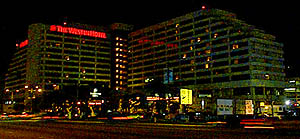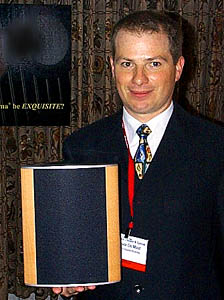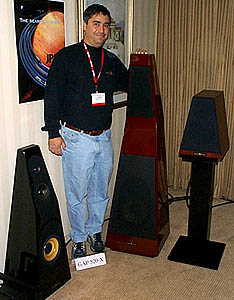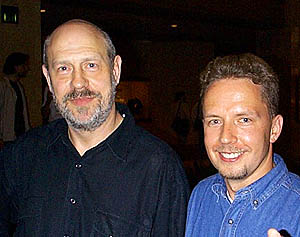|
![[SOUNDSTAGE! LIVE]](../covers/ssmainlive.gif) The Best in Online Trade Show Reporting Show Report SummaryHI-FI '98 Report: The Musicby John Upton
Software/source materials One of the bitterest of all ironies in high-end audio has always been the inverse relationship between the quality of the sound of a record or CD and the quality of its musical content. While there are, of course, some glorious exceptions, the more musically interesting recordings all too often suffer from poor engineering, ham-fisted mixes, careless mastering, and/or inferior manufacturing techniques. When such recordings are played back on components capable of the highest resolution, these shortcomings become far more noticeable, resulting in some excruciatingly frustrating listening experiences. After all, the whole point of owning a high-end audio system is to make your records and compact discs sound better, not worse, right? An inevitable corollary to this cynical rule of thumb is that the better the piece of high-end gear, the fewer the recordings capable of showcasing its sonic prowess. As such, the high end should be as much about the software as it is about the hardware. In show environments, however, the focus tends to shift inevitably to the hardware. Thus, I made a special effort to focus on the software of the show -- not only seeking out new and interesting products, but also identifying the reference discs used by manufacturers and exhibitors while demonstrating their systems. A bit about bits With all the speculation surrounding the next generation of digital software being bandied about in the audio press over the last year or so, I had high hopes of witnessing and reporting upon the emergence of the next standard in digital-disc technology. In that respect, however, the show was a bit of a disappointment. While it is entirely possible that showgoers heard a prototype of the CD of the future, it is impossible to determine at this time which of the active demonstration formats (if any) will emerge as the eventual ruler of the digital domain. Mike Hobson of Classic Records, one of the leading proponents of the 24-bit/96kHz school, was on hand to spin the latest "DAD" audio discs. First announced at the 1998 WCES, the DAD discs use the 24-bit/96kHz technology engineered into existing DVD players, although a handful of high-end manufacturers, including Theta and Muse, are producing dedicated DAD-ready equipment. I listened to the Classic recordings on the DAD system on active display, and the sonic capabilities of this format were clearly evident, even during my all-too-brief audition. The DAD works and works well. Of some concern, however, is the seeming lack of interest in the DAD by record labels outside the audiophile milieu. While Classic Records and Chesky certainly appear committed to this format, I did not notice a plethora of offerings from other companies. It will be interesting to track the progress of the DAD movement over the next year, especially if the industry heavyweights continue to bicker and dicker over the future of enhanced digital audio. If a viable enhanced-digital alternative is not forthcoming within the next year or so or if more record companies jump on the DAD bandwagon, we may already be listening to the big thing in digital audio. Speaking of industry heavyweights, Sony and Philips announced their alternate vision of the future of digital audio in the form of the "Super Audio Compact Disc" (SACD), a multi-layer, backward-compatible offering. Per the Sony/Philips plan, the "conventional" layer of the compact disc would hold the standard 16-bit/44.1kHz version of the recording, while the high-density layer could contain both two-channel and six-channel versions with room to spare for text, graphics, or video. The SACD would also feature Direct Stream Digital (DSD) technology, a one-bit-based system employing an extremely high 2.8mHz sampling rate, which Sony and Philips contend more accurately preserves the original analog event. Telarc International, DMP, and Mobile Fidelity, all early supporters of the Super Audio Compact Disc and DSD processes, supplied sample DSD tracks for demonstration. Although this demo did not offer direct A-B comparisons between DSD and conventional recordings of the same event, the demonstration tracks, particularly the multi-channel choral recording by DMP, were most impressive. Sony and Philips representatives were vague as to exact release dates of SCAD discs and playback gear, through they did hint at a spring 1999 release for the Japanese market. Stay tuned for domestic-release information. JVC XRCD2 JVC Music, Inc., the developer of the much-lauded XRCD (eXtended Resolution CD), announced the production and release of a new series of compact discs using the next generation of the process, XRCD2. Essentially an upgrade and refinement of the original XRCD concept, the XRCD2 discs are said to offer clearer definition, more accurate imaging, and higher overall sound quality. Akira Taguchi, the producer of the project, explained the philosophies behind XRCD during a spirited one-hour press conference. According to Taguchi, the highest-quality compact discs can only be produced through careful attention to every step in both the mastering and the manufacturing process. A&M Mastering's Alan Yoshida, the mastering engineer of the XRCD series, was also on hand to share horror stories of sending master tapes to manufacturing plants and receiving compact discs in return that bore only a passing semblance of the real thing. Together, Taguchi and Yoshida explained how the technical innovations in the XRCD process work to eliminate many of the pitfalls (sorry) inherent in the digital mastering and manufacturing process. Despite these significant technological advancements, producer Taguchi maintained that the human element is still vitally important in achieving the best possible compact discs -- stating that the success or failure of the end result is always 50% man, 50% machine. So what exactly is the XRCD process? Well, an analog recording selected for the XRCD program is played back on a custom-built deck through a specially designed mastering console. During this process, in addition to level matching from track to track, Yoshida explained that careful attention is paid to problems with the master tape itself. To the extent that polarity reversals, edit pops and other types of problems can be remedied, they are corrected at this stage. The analog signal is then fed into JVC's K2 A/D converter, where it is translated into 20-bit digital words. The digital information is re-generated through JVC's Digital K2 and transferred to a Sony PCM-9000 in its 20-bit form. The optical disk is then shipped to a dedicated XRCD line in JVC's Yokahama, Japan manufacturing facility for actual disc production. At the plant, the optical disk is played back through the same Digital K2 machine, where the digital signal is "bit down" to 16 bits, treated to another layer of K2 regeneration, and finally sent to the laser of the glass cutter. These elaborate production measures are designed in part to eliminate any time-based jitter in the data stream. While JVC appears to be on the leading edge of 16-bit/44.1kHz technology, they don't appear to have any immediate plans to offer any 24-bit/96kHz recordings. Taguchi maintained that a conventional compact disc can actually sound better that a 24/96 offering depending on the skill and innovation used in the mastering and manufacturing process. He also took on the issue of gold CDs, stating that JVC settled on the conventional aluminum coating after conducting extensive gold vs. copper vs. aluminum listening comparisons. Simply put, Taguchi stated that aluminum simply sounded the best. At the conclusion of the press conference, JVC handed out sampler discs mastered and manufactured using the XRCD2 process. Although I had the opportunity to hear several of the sampler tracks on assorted ultra high-end systems at the show, it wasn't until I returned home and played the sampler disc on my personal system that my initially favorable impressions were confirmed. The XRCD2 disc didn't sound like an analog recording, but it sure as hell didn't sound like most CDs in my collection either. It was smooth and extended at both frequency extremes, superbly detailed yet non-fatiguing. I suspect I may be using this sampler for reference purposes for the foreseeable future. Look for the first full release XRCD2 discs beginning July 21. SoundStage! has the first batch of XRCD2 discs as well as a selection of the original XRCDs in the review queue. Analog While CD systems tended to be the source component de jour in the vast majority of the active display rooms, a few exhibitors braved the difficulties and inconvenience of an analog front-end to offer show attendees a welcome taste of analog glory. Releases from Classic Records (especially the Mercuries) and DCC tended to dominate as reference materials, although the first release on Ying Tang's GrooveNote label was probably the record of the show. Recorded at the legendary Ocean Way studio in Los Angeles, California, Jacintha's Here's To Ben [GrooveNote 1001] is an all-analog, Bernie Grundman-mastered, direct-to-two-track recording pressed into a dead-quiet slab of 180-gram virgin vinyl. An exceptionally natural-sounding record, Here's To Ben is that rare combination of musical and sonic beauty. Featuring Teddy Edwards on tenor sax, Kei Akiga on piano, Darek Oles on bass, Larance Marables on drums, Jacintha breathes new life into a set of nine standards with a combination of innocence and poise perfectly captured through a purist miking technique. Ten seconds after Meadowlark's Srajan Ebaen put needle to groove on this one, I knew I had to have it. Here's To Ben is also available on gold CD, although I strongly preferred the vinyl in a quick A-B comparison. Either way, this recording is definitely of reference quality and belongs in your collection. Exhibitor picks I have always considered the demonstration tracks played in most exhibits to be a bit of a mixed bag. Sonically impressive but musically vapid, most demo materials tend to be nothing more than cotton candy for the ears -- sweet, but lacking in substance. I had equipped myself with my personal packet of reference discs to combat the tired audiophile war-horses I fully expected to encounter at HI-FI ‘98, but I was pleasantly surprised by the wide variety of interesting recordings I heard. Summarized below is a listing of some of the favorite demonstration CDs and LPs of this year's exhibitors.
Charles Lloyd Canto [ECM] (tracks 1 and 6) Monteiro, Young, and Holt Blues for the Saxophone Club [Golden Strings, HDCD] City of Angels Soundtrack [WEA/Warner] (Sarah McLaughlin's "Angel" cut) Dennis Had - Cary Count Basie 88 Basie St. [JVC XRCD] Ian McArthur - JMlabs/YBA Muddy Waters Folk Singer [Mobile Fidelity] Jennifer Warnes The Hunter [BMG/Private] Gary Pelled - Gallo Acoustics George Farber It Beats Workin' [Pope] Patricia Barber Cafe Blue [Premonition] Tutti! Orchestral Sampler [Reference Recordings] Gilles Gameiro - Birdland Audio Rachmaninoff Symphonic Dances for Orchestra [Classic DAD] John Lee Hooker Mr. Lucky [Virgin] Chesky DVD Super Audio Disc [Chesky] "Hutch" Hutchison - Manley Labs Ben Harper The Will to Live [Virgin] Ports of Call, Oue/Minnesota [Reference Recordings] David Soloman - Monitor Audio George Faber It Beats Workin' [Pope] Robben Ford and the Blue Line [Stretch] Kevin Hayes - VAC James Taylor Dad Loves His Work [Japanese CD] Harry James (Sheffield Labs releases) Jim Ricketts - tmh audio (WAVAC, Kochel) Margie Gibson Say it with Music [Sheffield Lab] Red Rodney 1957 [Analog Productions] Ella Fitzgerald Ella Fitzgerald Sings the Cole Porter Songbook [Verve] Ray Baumann - Music Advancement Company Madeleine Peyroux Dreamland [Atlantic]
Terry Evans Come to the River [AudioQuest] Sara K Hobo [Chesky] Keb’ Mo’ Just Like You [Okeh/Epic] Jean Marc Serres - Kora Mike Scott Bring 'Em All In [Chrysalis] John Campbell One Believer [WEA/Electra] Greg Brown Dream Cafe [Red House] Stevie Ray Vaughan Couldn't Stand The Weather [Sony] Jeff Starrs - Kora Scott Walker Tilt [Drag City] Astor Piazzolla Concierto pour Bandoneon [BMG] Leland Leard - Music Hall (Epos, Creek) John Martyn Church with One Bell [Thirsty Ear] Finley Quaye Maverick A Strike [Sony] Maier Shadi - Bow Technologies Elvis Presley Elvis is Back [DCC] (track 2, "Fever") Monster Cable Room Sneaker Pimps Becoming X [Virgin] Patricia Barber Modern Cool [Premonition] GNP Audio Room Ella and Louis Again [Mobile Fidelity] Srajan Ebaen - Meadowlark Jacintha Here's to Ben [GrooveNote CD/LP] Ella Fitzgerald & Louis Armstrong Porgy & Bess [Verve LP] Isik Dogudan Yukselir Ex Oriente Lux [Tempa & Foneks] (Turkish Music) Thomas Compagna - Quintessence Acoustics John Basile Quartet The Desmond Project [Chesky] Livingston Laylor Ink [Chesky] Rebecca Pidgeon Four Marys [Chesky] Manfredo Fest Just Jobim [DPM] June Tabor Aleyn [GLCD] Eiji Oue Exotic Dances from the Opera [Reference Recordings] Craig Uthus - Moth Audio Holly Cole Temptation [Metro Blue] Diane Krall All for You [Impulse!] Jacintha Here's to Ben [GrooveNote CD/LP] Mike Mailloux - LeDoux Pat Metheny The Road to You [Geffen] Kevin Zuccaro - AR/Advent Dave Matthews Crash [BMG] Cassandra Wilson Dance to the Drums Again [Sony]
Witches Brew [Classic LP] Tchaikovsky Nutcracker Suite [Mercury Living Presence LP] NHT Room Various tracks including: Primus "Shake Hands with Beef" Rage Against the Machine "Killing in the Name" Butthole Surfers "The Annoying Song" Fairfield Four "How I Got Over" John Coltrane "Blue Train" Claude Vaniscotte - Em-Phi HDCD Sampler Volume II [Reference Recordings] Berlioz Symphonie Fantastique [Reference Recordings] Gilbert "Elevator Boy" Yeung - Blue Circle Audio Dave Brubeck Quartet Time Out [Sony]
|
|
Copyright © 1998 |
|
![[SOUNDSTAGE]](pics/toplefttop.gif)

 HI-FI '98 featured an interesting and eclectic mix
of products and technologies old and new; two-channel and multi-channel systems; analog
and digital, tube and transistor equipment; good and, well, occasionally not so good
sound. With ten floors of the Westin airport hotel largely dedicated to active product
demonstrations, four ballrooms filled with display booths, and a steady stream of press
conferences and seminars, there were enough exhibitions and events offered to keep even
the most dedicated show reporters (the SoundStage! coverage team, of course)
scrambling to cover the entire five-day event.
HI-FI '98 featured an interesting and eclectic mix
of products and technologies old and new; two-channel and multi-channel systems; analog
and digital, tube and transistor equipment; good and, well, occasionally not so good
sound. With ten floors of the Westin airport hotel largely dedicated to active product
demonstrations, four ballrooms filled with display booths, and a steady stream of press
conferences and seminars, there were enough exhibitions and events offered to keep even
the most dedicated show reporters (the SoundStage! coverage team, of course)
scrambling to cover the entire five-day event.  Trevor de Maat (right) - TreMa Sound [Kharma,
O.L.S.]
Trevor de Maat (right) - TreMa Sound [Kharma,
O.L.S.] Joe Skubinski - JPS Labs, Ofra Gershman and Eli
Gershman (right) - Gershman Acoustics
Joe Skubinski - JPS Labs, Ofra Gershman and Eli
Gershman (right) - Gershman Acoustics Victor Khomenko (right) - Balanced
Audio Technology
Victor Khomenko (right) - Balanced
Audio Technology